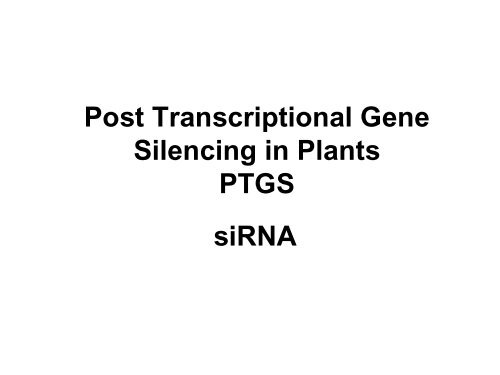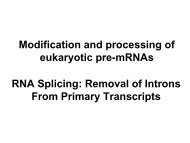Post Transcriptional Gene Silencing in Plants (PTGS) - Eurasnet.info
Post Transcriptional Gene Silencing in Plants (PTGS) - Eurasnet.info
Post Transcriptional Gene Silencing in Plants (PTGS) - Eurasnet.info
You also want an ePaper? Increase the reach of your titles
YUMPU automatically turns print PDFs into web optimized ePapers that Google loves.
POST TRANSCRIPTIONALGENE SILENCING -<strong>PTGS</strong><strong>Plants</strong>: Cosuppression or Epigenetic gene silenc<strong>in</strong>g:1990: found that transgenes could suppress the expression of similar endogenousgenes. which resulted <strong>in</strong> loss of function <strong>in</strong> 10-40% of the transgenic plants.Exp: Chalcone synthase (anthocyan<strong>in</strong> synthese pathway ) <strong>in</strong> PetuniaCaMVGenNOS-TerCaMV: Cauliflower Mosaic Virus PromotorNOS-Ter: Nopal<strong>in</strong>synthase Term<strong>in</strong>atorBoth, endogenous and transgene were transcribed but almost no mRNA wasdetectable, so silenc<strong>in</strong>g is on the RNA level RNA silenc<strong>in</strong>g (not genesilenc<strong>in</strong>g), cod<strong>in</strong>g region was methylated.
GENE SILENCING<strong>PTGS</strong>: <strong>Post</strong> transcriptional gene silenc<strong>in</strong>gTGS: <strong>Transcriptional</strong> gene silenc<strong>in</strong>gTGSHDGS: Homology dependentgene silenc<strong>in</strong>g<strong>PTGS</strong>-) promotor <strong>in</strong>active-) promotor methylated-) chromat<strong>in</strong> remodell<strong>in</strong>g-) frequently meiotically heritable-)both transgene and endogenousgenes are methylated-) non symmetrical methylation(non CG or CNG) → hallmark ofRNA directed DNA methylation.-) X <strong>in</strong>activation: Xist – Tsix:dsRNA? and methylation-) transcribed, but no fulltranscript found-) cod<strong>in</strong>g region methylated-) not dependent on ongo<strong>in</strong>gtranslation-) fully reversible dur<strong>in</strong>g meioses
<strong>PTGS</strong> can also be <strong>in</strong>duced by homologous DNA, with nopromoter sequence (m<strong>in</strong>imal length 300 bp) „ectopicpair<strong>in</strong>g“ aberrant RNAGrant,S., 1999, Cell, Vol. 96, 303–306.
N. clevelandii - TMV: systemic <strong>in</strong>fection with strongsymptoms
Cross protection: for several viruses an RNA mediated process:Model system: Potato virus X (PVX)Additional:recomb<strong>in</strong>ant PVX virus: with exonsequences of an endogenous gene:gene expression was suppressed ifthe virus was replication competent(virus replication: ds RNA): decl<strong>in</strong>eof viral RNA and host mRNA:VIGS: virus <strong>in</strong>duced gene silenc<strong>in</strong>g
GFP-Nicotiana benthamiana – model plantfor <strong>PTGS</strong>Transgenic Tobacco GFP plant <strong>in</strong>fectedwith Agrobacteria conta<strong>in</strong><strong>in</strong>g a GFP geneConstruct with a GFP genefor Agrobacteria transformationC: GFP express<strong>in</strong>g plantD: silenced plantBrigneti et al., 1998, EMBO J. 17, 6739-6746
Fire, A. TIGS, 15, 358 (1999)
POST - TRANSCRIPTIONALGENE SILENCING -<strong>PTGS</strong>„RNA <strong>in</strong>terference“ RNAi, a phenomenon <strong>in</strong> C. elegansand Drosophila for silenc<strong>in</strong>g of gene expression through asignal <strong>in</strong>duced by double stranded RNA (dsRNA)C. elegans: <strong>in</strong>jection of dsRNA: correspond<strong>in</strong>g gene productdisapears <strong>in</strong> the somatic cells, also <strong>in</strong> F1 generation.However, F2 normal phenotyp, no mutation, no sequencedifference: is post-transcriptional because only exonsequences show RNAi. In polycistronic pre-mRNAs only thesequences of the <strong>in</strong>itial dsRNA are silenced. RNAdegradation is at the level of nucleus and cytoplasm.WHAT HAPPENS? WHY is DEGRADATIONtransmissible through the whole organism??
<strong>PTGS</strong>: siRNAs<strong>Plants</strong>: 1999: small RNAs of 21- 25 nt were detected which correspondedto the silenced gene, but only detectable <strong>in</strong> plants which were silenced. Alsofor viral sequences(Hamilton and Baulcombe, Science, 286, 950).Drosophila: <strong>in</strong>duced silenc<strong>in</strong>g of a gene with a dsRNA, cell extract hadnuclease activity which was sequence specific: partial purified nucleaseconta<strong>in</strong>ed sequence specific 21-25 mers.Cell extract could be <strong>in</strong>duced with dsRNA to process the dsRNA <strong>in</strong>to21-23 nt RNA (dsRNA nuclease). Addition of mRNA resulted <strong>in</strong> degradationof sequences correspond<strong>in</strong>g to the orig<strong>in</strong>al dsRNA sequence: siRNA: small <strong>in</strong>terfer<strong>in</strong>g RNAs: hallmark <strong>in</strong> RNA silenc<strong>in</strong>g
A Model for the RNAi PathwayZamore, P.D., Nature structural biology, 8 (2001), 746RISC: RNA <strong>in</strong>duced silenc<strong>in</strong>g complex
An <strong>in</strong>tegrated model for RNAi and <strong>PTGS</strong>Hutvagner, G. and Zamore, P.D., Current Op<strong>in</strong>ion <strong>in</strong> <strong>Gene</strong>tics & Development, 12 (2002), 225
Virus <strong>in</strong>duced gene silenc<strong>in</strong>g (VIGS)RNA of a virus +a gene of <strong>in</strong>terestRdRpdsRNAdegradation of viral RNADicer-likedsRNaseRISC-like nucleasecomplex21-25nt siRNAEndogenous mRNANucleusmRNA degradation
Systemic silenc<strong>in</strong>g: mobile signalsilenc<strong>in</strong>g signal moves both cell-to-cell and throughphloem mimick<strong>in</strong>g pattern of viral movementscionGUS express<strong>in</strong>g plant: scionGUS silenced rootstockhistochemical sta<strong>in</strong><strong>in</strong>g showsthat movement of the signal <strong>in</strong>toscion is first evidenced by theabsence of blue color <strong>in</strong> theregions along the ve<strong>in</strong>sMlotshwa et al., The Plant Cell, Supp. 2002, S289
Viral cell-to-cell movement proceedsthrough plasmodesmatacell wallplasmodesmataplasmodesmata provide an <strong>in</strong>tercellular transport pathway for small molecules
Intercellular transport of TMV RNA?transport viamicrotubuliPlasmodesmanucleusmovementprote<strong>in</strong>viralgenomesynthesis ofviralcomponentsModified from Lazarowicz and Beachy, Plant Cell, 1999
Tobacco Mosaic virus movement prote<strong>in</strong> (TMV-MP)opens plasmodesmata10 kDa fluores. Dextran10 kDa fluores. Dextran+ TMV-MPN. tabacum
Viruses fight back: suppressors of RNAsilenc<strong>in</strong>gtransgenic GFP plantPotato virus Y15 d post InokulationPlant viruses all have RNAsilenc<strong>in</strong>g suppressors:PVX-p25 movement prote<strong>in</strong>:affects systemic silenc<strong>in</strong>g,HcPro-Potyviruses: suppressproduction of small RNAs,important for virus <strong>in</strong>fectivity
Viral strategies for suppression and evasion of RNA-silenc<strong>in</strong>ga | Direct <strong>in</strong>terference with silenc<strong>in</strong>g-effectormolecules is illustrated by the tombusviral P19prote<strong>in</strong>. The head-to-tail organization of thetombusviral P19 homodimers (blue and green)allows b<strong>in</strong>d<strong>in</strong>g to small <strong>in</strong>terfer<strong>in</strong>g RNA (siRNA)duplexes (yellow). Two sets of tryptophanresidues (yellow) b<strong>in</strong>d to the last set of base pairson either end of the siRNA, lead<strong>in</strong>g to effectivemeasurement of the duplex length, such that P19selects siRNAs of 21nt for b<strong>in</strong>d<strong>in</strong>g. Thesequestered siRNA is prevented from enter<strong>in</strong>gthe RNA <strong>in</strong>duced silenc<strong>in</strong>g complex (RISC) andis therefore <strong>in</strong>activated.b | Recruitment of endogenous negativeregulators of RNA silenc<strong>in</strong>g is illustrated by thepotyviral helper component prote<strong>in</strong>ase (HcPro).HcPro <strong>in</strong>teracts with the calmodul<strong>in</strong>-like prote<strong>in</strong>rgsCaM (regulator of gene silenc<strong>in</strong>g CaM) to<strong>in</strong>activate the RNA-silenc<strong>in</strong>g pathway throughan unknown mechanism at an <strong>in</strong>termediate stepthat <strong>in</strong>volves both RISC and Dicer.
RNA-based silenc<strong>in</strong>g strategies <strong>in</strong> plantsMatzke et. al., Current Op<strong>in</strong>ion <strong>in</strong> <strong>Gene</strong>tics & Development 2001, 11:221–227
More Dicer prote<strong>in</strong>s <strong>in</strong> plants<strong>Plants</strong>: short siRNA: 21-22nt, correlate with sequence specific degradation;long siRNA 24-26 nt <strong>in</strong>volved <strong>in</strong> trigger<strong>in</strong>g systemic silenc<strong>in</strong>gVo<strong>in</strong>net, Trends <strong>in</strong> Plant Science, 8, 307, 2003
<strong>Gene</strong>ral pathway of RNAi <strong>in</strong> vitroRNAi: RNA <strong>in</strong>terferencesiRNA: small <strong>in</strong>terfer<strong>in</strong>g RNARISC: RNA-<strong>in</strong>duced silenc<strong>in</strong>g complexSontheimer, NRMCB, 2005, p127
Chemical Mechanism of RISC-catalysed target-mRNA cleavageSlicer: enzyme which cuts the target strand, strong evidence that Ago prote<strong>in</strong>s possessthis activity. Crystal structure show that the PIWI doma<strong>in</strong> of Ago prote<strong>in</strong>s are very similarto RNaseH and harbour endonuclease activity. Like RNase H it is dependent on divalentmetal ions, produces 3‘OH and 5‘P and only cleaves onestrand of the duplex RNA.
siRNA asymmetry, dsRNA process<strong>in</strong>g and the implicationsfor RISC assembly.a | When 21-nt short <strong>in</strong>terfer<strong>in</strong>g (si)RNAs are used to <strong>in</strong>itiate RNA <strong>in</strong>terference (RNAi), the strand with its5‘ term<strong>in</strong>us at the thermodynamically less stable end of the duplex is preferentially <strong>in</strong>corporated <strong>in</strong>to theRNA-<strong>in</strong>duced silenc<strong>in</strong>g complex (RISC). The guide strand is shown <strong>in</strong> red and the passenger strand <strong>in</strong>blue. Less stably base-paired regions of the siRNA are depicted <strong>in</strong> grey and the more stable regions areshown <strong>in</strong> black.b | Dicer (Dcr) generates siRNAs from the ends of double-stranded (ds)RNAs. The multiple doma<strong>in</strong>s thatare found <strong>in</strong> most Dcrs (the RNA helicase, DUF283, PAZ, RNase IIIa (RIIIa), RNase IIIb (RIIIb), anddsRNA-b<strong>in</strong>d<strong>in</strong>g (dsRBD) doma<strong>in</strong>s) are shown. Current models <strong>in</strong>dicate that Dcr <strong>in</strong>teracts with nascentsiRNAs asymmetrically, with its PAZ doma<strong>in</strong> bound to the pre-exist<strong>in</strong>g dsRNA end and its dsRBD boundcloser to the dsRNA-cleavage sites (arrows). The dual roles of Dcr <strong>in</strong> dsRNA cleavage and RISC assembly<strong>in</strong>dicate that Dcr might rema<strong>in</strong> bound to the siRNA after it is processed from the dsRNA precursor.Comb<strong>in</strong>ed dsRNA-process<strong>in</strong>g and target-cleavage assays suggest that the strand that has its 3‘ end boundto the PAZ doma<strong>in</strong> preferentially assembles <strong>in</strong>to RISC.
dsRNA process<strong>in</strong>g by dicer and RISC formationpassenger strandguide strandRISC: RNA <strong>in</strong>duced silenc<strong>in</strong>g complex.thermodynamic asymmetry rule: for synthetic siRNA strand selection: The strand whichhas the its 5‘ end at the less stably base-paired region becomes the guide strand.
RISC Assembly <strong>in</strong> Drosophila







